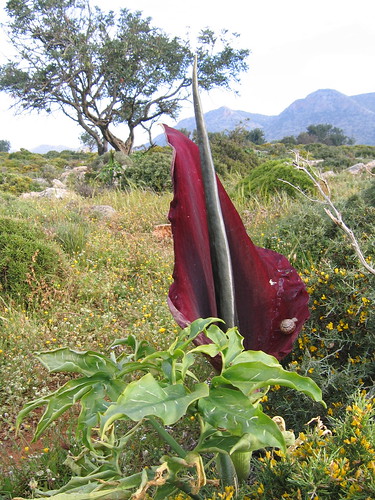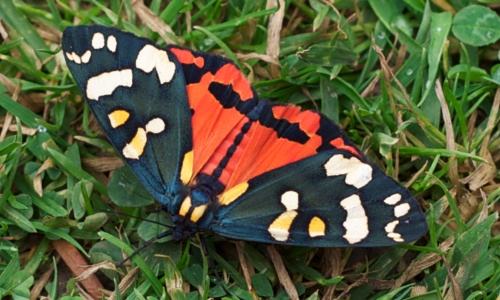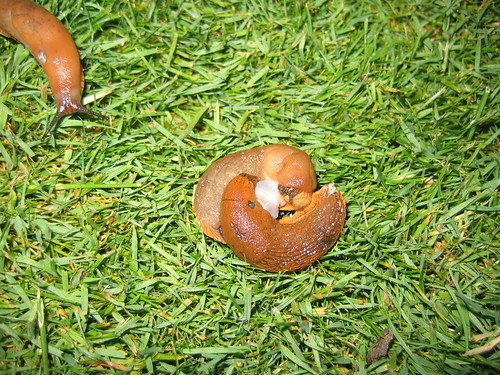Best Plant
There’s lots of choice here; I’ll just give a hat-tip to the big trees of Kew Gardens and Greenwich Park which I got over excited about in the autumn.
But most of the possibilities were in Crete. Crete has more species of plant than the UK, and a bundle of them are endemics. In spring, it’s an amazing place for wildflowers. Among too many species to mention were little white cyclamens, two species of asphodel, and at least eight different orchids. For example, according to my own notes on Flickr which may or may not accurate, this is either Ophrys phryganae or Ophrys sicula:

Either way it’s a cute little thing. But marvellous though all these delicate little wildflowers were, my plant of the year was something bigger and more grotesque: Dracunculus vulgaris, the Dragon Arum. I was just blown away by this thing. I mean look at it! It’s about four foot tall and apparently gives off a smell of rotting flesh, though on balance I’m pleased to say I didn’t notice it.

Best Insect
A quick mention for the attractive/destructive rosemary beetles that have been eating my herbs. And I saw Scarce Swallowtail in Crete which is a nice butterfly. But the clear winner this year is the Jersey Tiger moth that appeared in the garden. In the UK the Jersey Tiger used to be confined, as the name suggests, to the Channel Islands and the south coast of Devon, but over the past couple of years a colony has mysteriously sprung up in south London. No-one knows how they got here but it’s very exciting. Particularly as I hadn’t heard the news when I saw one in the garden.
Best Invertebrate (other) and Best Fish
Considering that invertebrates make up such a large proportion of the world’s species, it’s slightly embarrassing to admit I can’t think of a winner. Not a single noteworthy crustacean, mollusc, cephalopod, arachnid, cnidarian or anything else. The fish thing is less surprising, as I didn’t spent any time in a boat or diving or snorkelling last year. Still, in 2008 I must do better.
Best Amphibian
A tree frog I saw in Crete.

Best Reptile
I was having some difficulty thinking of any contenders here, but in the end I came up with two, both lizards. One was a slow-worm, a species of legless lizard, which I saw on a country walk; the other was the Balkan Green Lizard, remarkable for being big, fat, and super-super-green. I think the BGL edges it.
Best Mammal
I could only think of one possibility here, but it’s quite a good one. It’s an unidentified bat species. I was in Chania, in Crete, and kept hearing distant bat-squeaks. But despite plenty of street-lighting, I couldn’t see any bats, so I was starting to wonder whether it was something else. But standing in the square in front of the church and gazing up one evening, I managed to see the bats flying around. I noticed than sometimes one bat would chase another one, and I could hear the squeaking get louder and faster. But what was really exciting was seeing a bat chase a moth, and hearing the bat’s calls, which were normally quite sporadic, accelerate up to a crescendo as it approached the moth. I knew that bats did this: given that they ‘see’ with sonar, it’s their equivalent of shining a flashlight. It lets them see more accurately. But I didn’t really expect to observe it with the naked eye (and naked ear). So that was cool.
Best Ecosystem
Up in the mountains above the Lasithi plateau, I found what I think was the closest I’ve ever encountered to a wild version of the classic Alpine garden: lots of big rocks, and growing between them were these delicate little dwarf flowers in endless varieties. It’s an ecosystem for obsessive-compulsives; walk slowly and keep your eyes at your feet. Or to be more accurate, climb up off the path and scramble over the rocks, keeping your eyes at your feet. I took lots of pictures of the flowers but none quite capture the general appearance of the mountainside as I remember it. This will do, though. It’s a picture I took of an orchid, possibly Orchis tridentata:

That flower spike is probably only five or six inches tall, and it was all like that: small flowers between the rocks. The casual walker might get an impression of plentiful floweriness, but to really appreciate the richness of the environment it needed careful, patient searching.
I’d always imagined Alpine plants being kept small by cold and wind; as having a short growing season when the snow melted. In this case the opposite was true; they have a brief, early flowering season before Crete becomes bakingly hot and dry. And above all the ecosystem is maintained by goats. Give it three hundred years without any goats or sheep, and Crete, like all the Greek islands, would apparently revert to forest. It’s an interesting angle on the richness of Crete’s flora; I don’t know how long the goats have been there, but it’s a thousands rather than millions of years. Were all those Cretan endemics existing in tiny fragmentary environments beforehand, but able to take advantage of the changes the goats created? Or have they evolved in those few thousand years?

Either way, if you get the chance to visit Crete in April, I recommend it.










